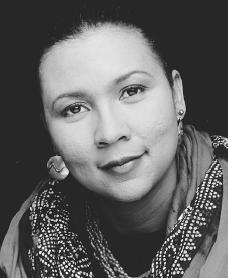Bell hooks
From Geography
AnneStrien (Talk | contribs) |
AnneStrien (Talk | contribs) |
||
| (5 intermediate revisions not shown) | |||
| Line 1: | Line 1: | ||
| - | bell hooks (intentionally uncapitalized) (born 1952) is an african-american cultural critic exploring the impact of racism, slavery and sexism on black woman. She discusses marginal communities in her postmodern black 'politics of location', striving for access for all communities. She chooses marginality as a space of radical openness, where she refuses the margins to be 'othered', actively taking the margins as a space for empowerment and action. | + | [[File:Uewb_05_img0351.jpg]] |
| + | |||
| + | Gloria Jean Watkins, better knows as bell hooks (intentionally uncapitalized) (born September 25, 1952) is an african-american cultural critic exploring the impact of racism, slavery and sexism on black woman. She discusses marginal communities in her postmodern black 'politics of location', striving for access for all communities. She chooses marginality as a space of radical openness, where she refuses the margins to be 'othered', actively taking the margins as a space for empowerment and action. Bell Hooks discusses in her work a lot of concepts. One of the main concepts is [[Hybridity]]. Hybridity is racial mixing. | ||
| + | |||
== Home-place == | == Home-place == | ||
| - | + | With a term made influential by her, 'Home-place', hooks elaborates on the differences in race spacially visible by the division of a railroad track in her Kentucky hometown. Showing how this racial differentiation came to being. But this 'living on the edge' made her look at the world as a whole, seeing it both from the inside and the outside, from the center to the margins. She makes a distinction in marginality oppressed from structures from above, and marginality as a space of resilience. So in that sense she sees marginality not only as disabling (restraining, and spatially dividing) but also as enabling (O. Kramsch, hoorcollege Black Postmodernism, Nijmegen, 9 oktober 2012). | |
| + | |||
| + | ==Contributors== | ||
| + | *''page created by Anne Strien''--[[User:AnneStrien|AnneStrien]] 10:18, 10 October 2012 (CEST) | ||
| + | *''page enhanced by Lotte den Boogert''--[[User:LottedenBoogert|LottedenBoogert]] 16 october 2012 | ||
| + | *''page enhanced by Paul van den Hogen''--[[User:PaulHogen|PaulHogen]] 14:28, 23 October 2012 | ||
| + | *''page enhanced and picture added by Anne van Strien''--[[User:AnneStrien|AnneStrien]] 09:52, 26 October 2012 (CEST) | ||
| + | |||
| - | + | [[Category: Persons]] | |
Latest revision as of 07:52, 26 October 2012
Gloria Jean Watkins, better knows as bell hooks (intentionally uncapitalized) (born September 25, 1952) is an african-american cultural critic exploring the impact of racism, slavery and sexism on black woman. She discusses marginal communities in her postmodern black 'politics of location', striving for access for all communities. She chooses marginality as a space of radical openness, where she refuses the margins to be 'othered', actively taking the margins as a space for empowerment and action. Bell Hooks discusses in her work a lot of concepts. One of the main concepts is Hybridity. Hybridity is racial mixing.
Home-place
With a term made influential by her, 'Home-place', hooks elaborates on the differences in race spacially visible by the division of a railroad track in her Kentucky hometown. Showing how this racial differentiation came to being. But this 'living on the edge' made her look at the world as a whole, seeing it both from the inside and the outside, from the center to the margins. She makes a distinction in marginality oppressed from structures from above, and marginality as a space of resilience. So in that sense she sees marginality not only as disabling (restraining, and spatially dividing) but also as enabling (O. Kramsch, hoorcollege Black Postmodernism, Nijmegen, 9 oktober 2012).
Contributors
- page created by Anne Strien--AnneStrien 10:18, 10 October 2012 (CEST)
- page enhanced by Lotte den Boogert--LottedenBoogert 16 october 2012
- page enhanced by Paul van den Hogen--PaulHogen 14:28, 23 October 2012
- page enhanced and picture added by Anne van Strien--AnneStrien 09:52, 26 October 2012 (CEST)
